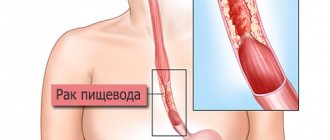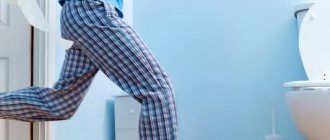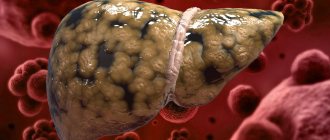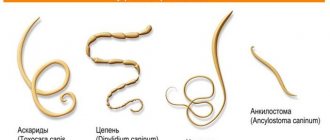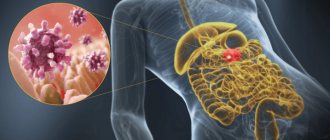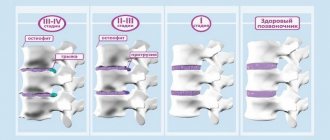Constipation is a persistent dysfunction of the large intestine with a reduction in stool frequency less than 3 times a week. Atonic constipation, or slow transit constipation, is understood as a condition that is associated with a decrease in muscle tone in a section of the intestine or almost its entire length (failure of peristalsis).
May result from structural, mechanical, metabolic and corticovisceral influences on the colon.
Constipation occurs when bowel movements occur less than three times a week.
What is atonic constipation
Under the influence of many provoking reasons, there is a decrease in the tone of the smooth muscles of the intestines. Atonic constipation is a condition in which peristalsis is disrupted - a wave-like contraction of the walls that promotes the movement of feces. This leads to changes in the functioning of the digestive system. This situation can cause:
- the appearance of painful sensations;
- accumulation of a large amount of feces;
- the need for enormous effort to perform defecation;
- ruptures, cracks in the anal mucosa due to the large diameter of the stool.
Characteristics of the pathology
Constipation means prolonged retention of feces in the large intestine or difficult and infrequent bowel movements. Constipation occurs as a result of slow movement of feces through the intestines, when it is impossible (difficult) to empty due to poor coordination of the pelvic floor muscles or when the motor function of the colon is impaired.
Constipation is characterized by impaired intestinal motility, a weakening of the urge to defecate, and a discrepancy between the intestinal capacity and the contents contained in it.
Atonic constipation
Atonic constipation is called constipation, which occurs as a result of decreased motor activity of the large intestine . They appear as a result of mild irritation of the nerve endings of the intestine or with a partial loss of perception of irritation.
A deficiency in nerve fiber stimulation can occur when there is a small amount of feces in the intestine, a poor diet, or when hormonal regulation in the body is disrupted. The cause may also be depletion of the nerve receptors of the intestinal wall with frequent use of an irritating factor (enemas, potent laxatives).
Important! Severe diseases, especially infectious ones, can give rise to a decrease in the tone of the neuromuscular apparatus of the intestine and the development of atonic constipation.
Spastic
Spastic constipation is a change in the normal, physiological movement of feces through the intestines due to a violation of its peristalsis . It becomes erratic and intensifies.
Occurs in inflammatory diseases of the gastrointestinal tract (dysbacteriosis, worms, polyps) due to a reflex response from inflamed organs in the abdominal cavity. Also, the cause of this type of constipation may be “psychological pressure” due to fear of causing pain if there are ulcers, scars or hemorrhoids in the rectum.
It has been established that spastic constipation in 50% of cases occurs with painful bowel movements . To avoid it, a person deliberately delays the act of defecation.
Causes
The appearance of a functional atonic disorder occurs as a result of diseases of the digestive organs. Constipation can be caused by changes in the conditions for normal bowel function. Pathology often occurs as a result of:
- lack of fluid in the body;
- disorders in the endocrine system - diabetes, obesity, hypothyroidism;
- natural processes of weakening of intestinal motility in older people;
- inflammatory diseases in the gastrointestinal tract;
- prolonged stress;
- pathologies of the nervous system - multiple sclerosis, Parkinson's disease.
The atonic type of stool disorder can appear in infants due to imperfections in the digestive system. The cause of constipation in adults sometimes lies in the following provoking factors:
- eating disorders;
- decreased physical activity;
- drinking water containing large amounts of lime;
- physical exhaustion caused by overload;
- long bed rest;
- disturbance of water-electrolyte metabolism;
- depression;
- toxic poisoning;
- pathologies of the digestive tract - colitis, erosions, gastrointestinal ulcers.
An atonic state of the intestines in women can be caused by pregnancy, childbirth, ovarian dysfunction, and changes in the body during menopause. The following causes of constipation cannot be excluded:
- taking medications - antispasmodics, calcium antagonists, sedatives, antacids that reduce stomach acidity;
- laxative abuse;
- suppression of the act of defecation;
- consequences of surgery on the digestive organs;
- drug and alcohol abuse;
- adhesions;
- dehydration of the body;
- excess body weight.
Treatment
A person suffering from constipation is recommended to increase physical activity , drink a large amount of fluid per day (at least 2 liters), and predominate in the diet of dietary fiber, which retains water in the intestines and makes stool more liquid.
If these measures do not give the desired result , medications and other therapeutic methods are used.
Medicines
This method of treatment involves taking pharmacological drugs of various types.:
- Products that soften and increase the volume of feces in the intestines: agar-agar, bran, cellulose, kelp, flax.
- Drugs that stimulate intestinal motility: senna herb, Bisacodyl, castor oil, bile preparations.
- Stool softeners – all mineral oils.
- Bulk laxatives. They absorb liquid in the intestines, as a result of which it stretches and causes a spasmodic act of defecation.
- Osmotic drugs. Helps soften stool and increase its volume. They increase the number of bowel movements per week, improve stool consistency, relieve abdominal pain, and stimulate intestinal motility.
- Stimulants that irritate nerve endings in the intestines. They have a quick effect, the downside of which is diarrhea and cramping abdominal pain, the development of “lazy bowel” syndrome.
- Enterokinetics. Increase the secretion of water in the intestines, stimulate secretion in the colon.
Enemas
The essence of using an enema is that the liquid introduced into the rectum has a thermal and mechanical effect on it, enhances intestinal motility, and makes the stool loose.
Physiotherapy
Cutaneous and endorectal electrical stimulation , electrophoresis and thermal procedures (application of warm mud) are used.
There is also biofeedback therapy . It forms a conditioned defecation reflex subject to the loss of the unconditioned (self-regulation). Touch sensors are inserted into the anus to monitor anal contractions and, if necessary, stimulate them.
Physiotherapy
Exercise therapy involves performing a number of exercises that stimulate intestinal motility and normalize digestive processes :
- Exercise "Bicycle".
- Step in place, raising your knees high.
- From the knee-elbow position, do squats on the side of the thigh to the sides alternately.
- While lying on your back, alternately spread your legs bent at the knees to the sides.
- While lying on your back, make movements with your stomach. Inhale - bulge your stomach, exhale - draw in.
Important! Exercises should be done 2-3 times every day, and in between them you should stroke your stomach clockwise with light movements.
For spastic constipation
For this type of constipation, do the simplest exercises, followed by more complex ones in combination with breathing exercises. A superficial, shallow abdominal massage is used. The duration should not exceed 10 minutes. Instead of morning exercises, walking is recommended, but no more than 30 minutes at a time.
With atonic
Exercises are used to train the abdominal muscles, pelvic floor and diaphragm. Movements with a sharp amplitude (jumping, running, etc.) are contraindicated.
It is necessary to combine gymnastics with warm mud applications to the anal area. Massage is indicated using stroking circular and zigzag movements.
Yoga classes
The set of exercises involves performing the following asanas:
- tadasana (“mountain pose”);
- tiryaka-tadasana (“bending tree pose”);
- kati-chakrasana (“rotation of the waist”);
- Tiryaka-bhujangasana (“Turning Cobra Pose”);
- Udraka-karshanasana (“abdominal massage”).
Attention! All movements should be performed slowly and smoothly.
Diet
Foods that promote normal digestion and regular bowel movements:
- bran bread;
- raw vegetables and fruits;
- cereals;
- meat;
- fish fat;
- dairy products.
Prohibited foods that cause constipation:
Important! Food must be taken in small portions, 5-6 times a day and in small portions - for better digestion and absorption.
Folk remedies
In the fight against constipation, fresh juices from beets, cucumbers, apples, Jerusalem artichoke, carrots and plums have proven themselves well. Of the plants, senna, flax, dill, and caraway have a laxative effect. All oils used in daily use have a softening, laxative effect.
Symptoms
You need to know the difference between an atonic state and spastic constipation caused by intestinal spasms. This will help in the correct prescription of a treatment regimen and successful treatment. The following symptoms are characteristic of spastic functional disorder:
- increased gas formation;
- pain in the form of spasms;
- feeling of insufficient emptying after defecation;
- feces in the form of small individual fragments;
- feeling of fullness, bloating;
- decreased body tone;
- constant fatigue;
- lethargy.
The atonic form of the pathology is characterized by a large volume of feces and the appearance of a feeling of complete bowel movement after defecation. Symptoms of this condition may include:
- feeling of discomfort, slight heaviness in the stomach;
- the interval between bowel movements is up to seven days;
- the need to push for a long time;
- absence of severe pain;
- large diameter of feces with a dense structure;
- the appearance of cracks in the anus;
- streaks of blood in the stool.
Difficult bowel movements, problems cleansing the body of toxins, breakdown products, changes in microflora, often provoke the appearance of symptoms of intoxication. The patient may complain of:
- nausea;
- general weakness;
- decreased performance;
- pale skin;
- periodic increase in temperature;
- irritability;
- headache;
- loss of appetite.
Symptoms of the disease
The process of formation of hard stool and difficulty defecating can be observed for six months or more. Stagnation in the intestines is most often associated with malnutrition: a predominance of meat, flour and sweet dishes in the diet, lack of sufficient fiber. In this situation, the foods consumed do not properly irritate the intestinal mucosa. As a result, motor skills are impaired, which leads to congestion.
Also, the cause of constipation may be associated with a weakened human body, a sedentary lifestyle, or artificial suppression of the urge to defecate. With stagnation, the patient experiences a feeling of distension, a feeling of fullness in the intestines. Characteristic symptoms: constant aching pain in the abdomen. The initial portion of feces is dense, abundant, and well-formed. Subsequent stool is softer and shapeless. The act of defecation itself is painful and difficult.
The anal mucosa is often injured with the formation of cracks. After constipation, blood streaks appear on the surface of the stool.
Prolonged stool retention leads to the decomposition of feces and the reabsorption of waste products into the blood.
The general condition worsens, intoxication occurs. The temperature rises, nausea occurs, vomiting is possible, and the stomach is constantly bloated. A person loses appetite and loses weight. The skin takes on a pale green tint.
Atonic constipation in infants
The frequency of bowel movements is often impaired in newborns as a result of underdevelopment of the digestive system. Mothers need to monitor the child’s condition in order to promptly seek help from a pediatrician. It is necessary to sound the alarm if a baby experiences:
- stool less than twice a day (the norm is 4–10 acts);
- restlessness, crying during bowel movements;
- bloating;
- high density of feces;
- refusal to eat;
- poor sleep;
- capriciousness.
The cause of the atonic state, which causes constipation in the baby, may be a malnutrition in the mother. Provoking factors for the appearance of pathology often include:
- congenital anomalies of the colon;
- lack of fluid in the child’s body;
- lack of mother's milk;
- untimely introduction of complementary foods;
- sudden transition to nutritional formulas;
- taking medications by mother and child;
- lack of dietary fiber;
- lack of motor activity in the baby;
- psychological factors - separation from mother.
Preventing constipation
To prevent pathology, it is enough to adhere to the following recommendations:
- If you are prone to constipation, you should adjust your diet and exclude foods that strengthen the stool: sweets, flour, eggs, meat. Instead, eat more fresh fruits, vegetables, and cereals. They not only normalize the functioning of the gastrointestinal tract, but also remove harmful metabolic products, toxins, cholesterol, and excess glucose from the body.
- Consume only stewed and boiled foods.
- Drink at least 2 liters of water daily. Thanks to the liquid, the stool softens and easily passes through the intestines, defecation occurs quickly and painlessly.
- Don't overeat. It's better to undereat a little than to overfill your stomach.
- Periodically carry out fasting days. To restore intestinal motility, it is a good idea to do a one-day fast.
- Never hold back when you want to have a bowel movement. Such delay always leads to illness.
- Use laxatives only on the advice of a doctor. Well, if the problem lasts for quite a long time, then first it is better to try folk remedies for constipation.
- Lead an active lifestyle, do gymnastics, walk more.
If you follow all these recommendations and carefully monitor the condition of your body, you can soon improve not only intestinal motility, but also overall health.
https://www.youtube.com/watch?v=Yf76HKUUGgo
Diet for atonic constipation is a proven and optimal way to treat and prevent this condition. Even if the patient is prescribed medication, the diet must be adjusted to achieve a better result:
- Avoid chocolate, coffee, mushrooms, semolina, strong tea, and processed foods. You should not eat smoked foods, foods high in salt and spices;
- The diet for atonic constipation and bloating is aimed at including high-fiber foods in the menu. Eat oatmeal and buckwheat porridge, bran - they are rich in this useful substance;
- Include more raw fruits and vegetables in your diet. Carrot and beet juice are especially useful, but it is better to refrain from eating pears and cabbage;
- Take food on schedule, but in small portions; do not overeat - this leads to various problems with the gastrointestinal tract;
- It is worth limiting the consumption of sweets, white bread and fatty meats - they are real enemies of the intestines.
For preventive purposes, you need not only to eat right, drink enough water, but also exercise. Today, it is a sedentary lifestyle that causes fecal stagnation, leading to a decrease in the standard of living and other problems for thousands of people.
Having found out the symptoms and methods of treating atonic constipation, you should not refuse a visit to the doctor. A specialist will help you deal with a delicate problem much more effectively. Modern diagnostics can identify dangerous intestinal diseases that cause constipation in the early stages, so there is no need to ignore delayed bowel movements and drink laxatives uncontrollably - you will only harm yourself. To prevent this problem from arising in the future, it is recommended to review your diet and eat only wholesome, healthy foods.
Why is atonic constipation dangerous?
Decreased muscle tone if left untreated can lead to serious problems. The atonic state causes complications in the functioning of the digestive system. Patients sometimes experience pathologies:
- chronic constipation;
- intestinal dysbiosis;
- the appearance of cracks in the rectum;
- the occurrence of “lazy bowel” syndrome – a violation of its functions;
- development of hemorrhoids;
- diverticulosis - the formation of a protrusion on the walls of the intestine;
- prolapse of the pelvic organs due to weakening of the muscles;
- the appearance of secondary immunodeficiency;
- increased risk of developing neoplasms.
Differences between types of constipation
Constipation complaints may vary in nature and clinical manifestations. Below is a table of the difference between atonic and spastic constipation according to the main criteria.
| Spastic constipation | Atonic constipation | |
| Cause | Increased muscle tone in an area of the intestine, as a result of which stool cannot pass through it | An area of the intestine loses tone, stool cannot move further |
| Complaint | Spasms and colic in the abdominal cavity. Bloating |
Diagnostics
If symptoms of atonic bowel dysfunction appear, the patient should consult a doctor. An important diagnostic task is to differentiate constipation from the spastic form of the pathology, and to exclude the presence of neoplasms. This will help prescribe the correct treatment regimen. The appointment begins with anamnesis collection. The doctor finds out:
- having problems with bowel movements;
- character of feces;
- the occurrence of pain, discomfort in the abdomen, the appearance of blood streaks in the stool;
- the presence of signs of intoxication - temperature, nausea, pallor of the skin.
Palpation of the abdominal cavity reveals an enlarged spleen, liver, and the presence of tumor formations. A general blood test is required, which states:
- the appearance of anemia in hemoglobin content;
- development of inflammatory processes in terms of elevated ESR values (erythrocyte sedimentation rate), signs of leukocytosis.
To make an accurate diagnosis, instrumental diagnostics are used, which include the following methods:
- sigmoidoscopy - study of the rectum, the sigmoid part of the large intestine;
- irrigoscopy - X-ray examination with a contrast agent - identifying features of the movement of feces;
- Ultrasound of the pelvic organs - identifying gynecological, urological causes of constipation;
- endoscopic colonoscopy – determination of the condition of all parts of the colon.
Symptoms and signs
Atonic constipation is characterized by a chronic course. So-called “habitual constipation” has mild symptoms:
- bowel movements occur 2-3 times a week, while the person does not feel discomfort from the lack of bowel movements;
- feces that are dense and enlarged in diameter can lead to trauma to the rectal mucosa, resulting in cracks and ruptures of small vessels;
- on the 3rd–4th day of absence of stool, a feeling of heaviness and distension occurs;
- Chronic constipation leads to intoxication of the body, which is accompanied by loss of strength, headache, dry mouth, and changes in skin color.
Spastic constipation, which occurs from time to time, is accompanied by the following symptoms:
- cramping, short-term pain in the intestinal area;
- bloating caused by increased gas formation;
- belching air;
- an admixture of mucus in the stool;
- decreased appetite;
- unpleasant taste in the mouth;
- nausea.
Treatment of atonic constipation
When symptoms of pathology appear, an important task is to treat the underlying disease that caused constipation. For atonic disorders, doctors prescribe nutritional adjustments and the use of a special diet. The treatment regimen includes the following activities:
- adherence to eating and bowel movements;
- strengthening the abdominal muscles with special exercises;
- increased physical activity;
- performing a stimulating, relaxing abdominal massage;
- use of water procedures - baths, circular showers.
Medications are prescribed in case of an atonic state that has been observed for a long time. For this purpose, the following groups of drugs are used:
- antispasmodics – No-shpa;
- agents that increase the amount of feces - Calcium Polycarbophil;
- drugs that normalize muscle tone - Domperidone;
- choleretic drugs acting on intestinal motility - Allochol;
- laxatives – Macrogol;
- for dysbacteriosis - drugs to restore microflora - Linex;
- to soften the mucous membrane - glycerin rectal suppositories.
Sometimes enemas are prescribed as a therapeutic measure for atonic constipation. The procedure improves intestinal motility and relieves the feeling of heaviness. Treatment is carried out until constipation is eliminated, the volume of the drug does not exceed 150 ml. To do this use:
- olive, vegetable, castor oil - soften stool, improve its movement;
- decoction of chamomile, calendula, water with apple cider vinegar - cleanse the intestines;
- hypertonic (saline) solution - softens feces, acts as an irritant to the mucous membranes, provoking the act of defecation.
Articles on the topic
- Menstruation when taking contraceptives - why there are problems with menstruation and how to normalize
- Constipation remedies for the elderly - a list of the best medications and traditional medicine recipes
- Fast-acting anti-constipation suppositories for children and adults - types and rules of use, contraindications
Drug treatment
Prolonged atonic constipation is treated with medications. Their prescription depends on the accompanying symptoms. In case of problems with bowel movements, the following groups of medications are used:
- stimulants of peristalsis, increasing muscle tone - Itomed, Ganaton, Coordinax;
- antispasmodics that reduce pain, spasms - Drotaverine, Bralangin, Spazmalgon;
- choleretic agents that activate the effect of bile acids on the intestines - Cholenzym, Nikodin, Holagol;
- softening mucous membranes - Glycerin suppositories, Vaseline oil.
If there are problems with regular bowel movements, medications with a laxative effect are prescribed. Caution is required when using them. It is possible that addiction may occur, changes in water-electrolyte balance, and worsening peristaltic disturbances. There are drugs that differ in laxative effect:
- carry out delicate bowel movements - Izaman, Lizalak, Izafenin;
- have a mild effect and are not addictive - Phytomucin, Duphalac;
- produce an irritating effect - Senade, Regulax, Microlax.
The drug Itomed activates gastrointestinal motility, improves gastric and intestinal emptying, and is available in tablet form. The product eliminates abdominal pain, heartburn, bloating, and has the following features:
- indications – problems in the digestive system;
- dosage – 3 times 50 mg;
- side effects – headache, urticaria, drooling;
- contraindications – pregnancy, bleeding in the gastrointestinal tract, age under 16 years, lactase deficiency.
The laxative Izafenin is prescribed for constipation and atonic disorders. The drug is produced in tablets that begin to act in the alkaline environment of the intestines, cleansing it 12 hours after use. The medicine is characterized by the following properties:
- dosage – one tablet in the morning and evening;
- side effects - abdominal pain;
- contraindications – spastic intestinal obstruction, hypersensitivity;
- special instructions - it is unacceptable to drink alkaline mineral waters within an hour before and after taking the product.
The drug Drotaverine is an antispasmodic. It is prescribed for atonic constipation, accompanied by pain. The medicine in tablets, according to the instructions, has the following effect:
- indications – spasms of smooth muscles of the intestines, uterus, blood vessels;
- dosage – 2 tablets twice a day;
- side effects - dizziness, palpitations, decreased blood pressure;
- contraindications – liver, kidney, heart failure, pregnancy, childhood.
Diet
Proper nutrition plays an important role in the treatment of atonic constipation. The diet involves the use of large amounts of plant fiber, which stimulates intestinal function. There are recommendations for organizing meals, which include the following points:
- avoiding overeating and hunger;
- fractional meals;
- chewing thoroughly;
- using vegetable and fruit salads for breakfast;
- using warm dishes (cold and hot ones disrupt the normal digestion process);
- drinking fluids between meals.
Dietary nutrition for atonic constipation involves limiting sweet, salty, spicy and fatty foods. It is advisable to use first courses with cereals, vegetables, and their cold varieties - okroshka, beetroot soup. Nutritionists recommend drinking a glass of water with a spoonful of honey diluted in it before breakfast to get your bowels moving. The diet should contain the following products:
- vegetables - pumpkin, carrots, beets;
- fruits – sweet apples, bananas;
- whole grain wheat, rye bread.
For normal bowel function during constipation, it is necessary to regularly consume fermented milk products - yogurt, kefir, yogurt, and have on the menu daily:
- steamed dried fruits - prunes, dried apricots, figs;
- liquid porridges - buckwheat, oatmeal, pearl barley;
- boiled pasta;
- greens - salads, dill, parsley;
- fruit juices;
- bran;
- compotes;
- rosehip decoction;
- tea.
If you have frequent atonic constipation, you should exclude hot spices and chocolate from your daily use. The following products are prohibited:
- smoked meat, fish;
- flour products;
- canned products;
- animal fats;
- baked goods;
- dishes with mushrooms;
- bread made from premium flour;
- strong tea, coffee;
- White rice;
- alcohol;
- onion;
- garlic;
- radish;
- radish;
- semolina;
- mustard;
- eggs.
Exercises
In case of disturbances in the functioning of the digestive system, it is necessary to tone the abdominal muscles and activate intestinal functions. This can be done using a complex of special gymnastics. It is recommended to do the exercises daily, 10 times each. One of them should be performed in the starting position (IP) sitting on the floor, with the following sequence:
- place your hands on the floor behind your back;
- while inhaling, raise your pelvis, resting on your heels and palms;
- on exhalation, return to I.P.
The following exercises of the complex are performed in IP. lying on your stomach, legs straight, arms extended in front of you. It is important to pay attention to your breathing. Classes are conducted in the following order:
- While inhaling, raise your right arm and left leg. At the exit, return to I.P., repeat, changing arms and legs.
- "Breaststroke" As you inhale, raise your head and move your hands across the floor to your sides, placing them along your body. As you exhale, stretch your hands to the shoulder joints, return to IP.
- While inhaling, bend your right leg at the knee, pull up and to the side. As you exhale, return to IP, repeat for the other leg.
Folk remedies
Medicines prepared from natural ingredients at home can be part of complex therapy for atonic intestinal disorders. Doctors do not recommend self-medication so as not to trigger the disease or cause allergic reactions and complications. Traditional healers advise trying the following recipes that will help activate intestinal function:
- fresh aloe juice, a teaspoon in the morning and evening, half an hour before meals, course - a month;
- compote of dried cherries and apples – 4 glasses during the day.
A decoction of dill seeds will help improve intestinal functions. You will need to grind a spoonful of raw materials, pour boiling water (1.5 cups), leave for 30 minutes, drink in several doses throughout the day. It is useful to consume wheat bran, which should be prepared in this way:
- take 2 tablespoons of dry powder (sold at the pharmacy);
- add a glass of boiling milk;
- wrap up, soak for an hour;
- Consume 2 times on an empty stomach - in the morning before breakfast, in the evening - before bed.
How to distinguish spastic constipation from atonic constipation
Gastroenterologists distinguish two types of constipation, which have different mechanisms of progression, different causes and consequences, but a single symptom is stagnation of feces:
- Spastic constipation occurs when smooth muscle spasm occurs. The intestinal lumen decreases, creating an obstacle to defecation. The patient notes severe abdominal pain, which is of a wave nature. Such constipation is usually short-term, not regular, observed after stress or emotional overstrain;
- Atonic constipation - occurs when muscles relax, when peristalsis decreases, the lumen of the rectum increases, and feces stagnate in the body. The reasons are caused by the influence of the nervous system on the intestines. In this case, the problem is chronic, and defecation is difficult for a long time - from several months.
Having diagnosed atonic constipation in time, which is more dangerous than spastic constipation, you can cure it at home, without resorting to hospitalization.
First you need to understand the type of constipation, because for different forms, dietary recommendations will differ.
Expectant mothers more often experience atonic constipation, which is associated with a decrease in intestinal tone and a weakening of its motor activity. As a result, the intestines simply do not have enough strength to remove the contents. In this case, the initial portion of feces is, as a rule, very dense, large in diameter, and the final portion is semi-formed. The act of defecation itself is quite painful and difficult.
Spastic constipation can also occur in pregnant women. In this case, muscle spasm occurs in some parts of the intestine, and its contents cannot move further. A characteristic symptom is hard stool in small lumps (so-called sheep feces). Often such constipation is accompanied by cramping pain in the abdomen, a feeling of expansion and pressure, and increased gas formation.
One of the main ways to combat constipation is to follow dietary recommendations.
Doctors distinguish three types of defecation disorders:
- constipation that appears with colitis;
- atonic;
- spastic.
We'll talk about the latter in this article.
An imbalance of the gastrointestinal tract and nervous system is the main cause of spastic constipation. Strong emotional experiences, nervous shock, and psychological disorders lead to intestinal dysfunction: spasm of smooth muscles in certain areas causes a narrowing of its lumen. As a result, the movement of feces is delayed or completely stopped.
The diagnosis can only be made by a specialist - a gastroenterologist-infectious disease specialist, coloproctologist or therapist. An endoscopic examination of the intestinal cavity (fibrocolonoscopy), irrigoscopy (x-ray examination of the colon with the introduction of a contrast agent into it, sigmoidoscopy (examination of the intestinal area using a sigmoidoscope) and analysis of stool for microflora are carried out.
There are three stages:
- Compensation (bowel movements occur once every 2-3 days)
- Subcompensations (every 3-5 days)
- Decompensation (delay of 10 days or more)
Clinical manifestations of spastic constipation:
- strong wave-like spasms in the intestines
- bad breath
- belching
- increased gas formation
- spasm of the anal sphincter leads to difficulty in defecation,
- fragmentary stool (dense lumps)
- constipation is often replaced by diarrhea
- increased gastric acidity
With atonic constipation, a person is worried about:
- difficulty defecating, pain when pushing
- no urge to urinate
- bloating and feeling of pressure in the abdomen
- with a long absence of bowel movements, nausea and headaches occur, appetite disappears, general weakness and irritability are felt
- intestinal contents are dense, voluminous, dry
- frequent ruptures and cracks in the anal mucosa
- zero or reduced acidity of gastric juice
Regulatory dysfunction of the autonomic nervous system is a common cause. In addition, spasm often occurs:
- After food poisoning
- For colitis, diabetes mellitus 1 and 2 degrees, diseases of the pituitary gland, hypothyroidism,
- During menopause in women due to ovarian dysfunction
- During pregnancy
- Due to chronic intoxication of the body (with frequent contact with lead and mercury compounds)
- With excessive mental stress
- Under the influence of stress
- As a result of pathologies of the endocrine system
REFERENCE! In a child, constipation can be triggered by switching to artificial feeding, introducing a new food into complementary foods, feeding sweets, or lack of water. Sometimes this is affected by moving or moving to another school. Antispasmodic drugs are used in exceptional cases; rectal suppositories are sufficient.
It is impossible to cope with the problem by swallowing handfuls of pills or emptying your grandmother’s stock of healing tinctures. An individual diet, drug treatment and the use of folk recipes to maintain human strength - this is the most effective complex.
Medicines
IMPORTANT! Using laxatives without a doctor's prescription can cause your intestines to become accustomed to them. Sooner or later, this leads to the organ’s failure to cope with food on its own.
Most often, when defecation is delayed, doctors prescribe antispasmodics. They help restore the evacuation function and quickly relieve pain by relaxing the muscles of the walls. Papazol, dibazol, papaverine, no-spa are the most popular antispasmodics.
Laxatives are used as a last resort because they can cause decreased nutrient absorption and the death of beneficial bacteria.
If the pathology manifests itself against the background of depression, the doctor prescribes the patient a selective inhibitor (Indallin, Paroxetine, Citalopram) or a tricyclic antidepressant (Azafen, Elavil, Fluoracisine).
ATTENTION! They are distinguished by their uniqueness and availability of components, but before using them, consultation with a doctor is required! The best effect is achieved only by medical treatment coupled with the use of folk wisdom.
There are a lot of such tools, here are a few options:
- 15 g of dried plantain and sage, 5 g of mint, 15 g of St. John's wort and 10 g of marsh grass are mixed. A teaspoon of the mixture is poured into a glass of boiling water and left for half an hour. Drink 1/3 glass 3 times a day after meals.
- Flax infusion is good for relieving cramps. 3 tbsp. spoons of flaxseed are poured into 300 ml of boiling water and infused in a thermos for half an hour. Used after every meal.
- Pour 200 ml of boiled hot water 1 tsp. mint leaves, cover with a lid and leave for a quarter of an hour. Take 3-4 times a day, 60 ml.
- 1 tbsp. a spoonful of fennel seeds or dill, poured with boiling water, infused for 15 minutes and taken 100 ml during cramps.
You can buy useful mixtures at the pharmacy or make them yourself:
- Licorice rhizome, fennel seed, buckthorn bark, laxative zoster;
- Buckthorn bark, joster, anise, senna leaf, licorice rhizome;
- Watch leaf, tansy, valerian and calamus root, St. John's wort herb;
- Mint, cumin, anise, fennel.
Exercises aimed at relieving intestinal spasms are performed daily (if intestinal function is normalized, every other day).
The complex used for the treatment of osteochondrosis is excellent. It may include running in place, squats, crawling on all fours. The pace of classes is slow, without sudden movements. The optimal time for training is in the morning. Drinking a glass of warm water before starting significantly enhances peristalsis.
One workout lasts 20-30 minutes, each exercise is repeated from 6 to 15 times. In addition, it is recommended to do short warm-ups of 5-10 minutes throughout the day.
Swimming in the pool (2 hours after eating) also has a beneficial effect. It is useful to ski, ride a bike, jog and learn yoga.
IMPORTANT! For diseases such as hypertension, umbilical hernia and digestive tract ulcers, the doctor selects gentle exercise options.
REFERENCE! It would be a good idea to attend a soothing massage session. It includes stroking (flat superficial for 3-4 minutes and deep in the area of the colon for 7-8 minutes) and subsequent acupressure of the back. Session duration is 20-25 minutes. The patient can independently perform a light massage immediately after waking up, massaging the left groin for 5-6 minutes.
Cleansing enemas bring relief and are easy to do at home. The solution should not be cold, otherwise it will aggravate the spastic syndrome. A comfortable liquid temperature is approximately equal to body temperature – 36-38 degrees. Introduce slowly, without strong pressure.
There are several effective recipes for enemas against spastic constipation:
- Herbal infusions eliminate inflammation and relieve irritation of the gastrointestinal tract. Dry lemon balm and mint leaves are poured with boiling water for 15-20 minutes, then boiled for half an hour over low heat and cooled.
- Oil based. 200 ml is heated to 30-32 degrees and set overnight. Emptying occurs after 10-12 hours. Any oil can be used: olive, castor, sea buckthorn, vegetable.
- From a concentrated saline solution that increases peristalsis and softens stool. Dissolve 3-4 tablespoons of salt in a glass of water at room temperature. It starts working within 15 minutes.
- A tablespoon of apple cider vinegar is added to 2 liters of boiled water.
- Add a teaspoon of melted butter to 100 ml of milk, heat to 40 degrees and do an enema at night. It is advisable not to get up until the morning.
Forecast
When the first symptoms of atonic constipation appear, you should consult a doctor. Timely treatment gives a favorable prognosis. Help to successfully cope with the manifestations of atony:
- early diagnosis;
- identifying the causes of constipation;
- their timely elimination;
- compliance with all doctor's prescriptions;
- implementation of preventive measures to exclude recurrent cases of pathology;
- nutrition correction;
- special gymnastics classes.
Methods for treating constipation
In most cases, diet and special exercises help overcome atonic constipation. Treatment necessarily involves nutritional correction. The patient should include foods rich in fiber in his daily diet: pumpkin, carrots, prunes, beets. It is useful to eat buckwheat and oatmeal. In this case, vegetables and fish should be taken boiled. Eating must take place according to schedule.
As for physical activity, it is an integral part of the treatment of constipation. Doctors have developed a set of special exercises that help strengthen the abdominal muscles. To eliminate constipation in children, therapeutic abdominal massage is recommended.
If the described methods do not eliminate atonic constipation, therapy is supplemented with laxatives.
Prevention
To prevent the occurrence of atonic constipation, doctors recommend adhering to a diet that eliminates constipation. An important role is played by increasing physical activity, strengthening the pelvic floor and abdominal muscles. Prevention of atony includes the following measures:
- eating fruits and vegetables rich in natural fiber;
- compliance with the drinking regime - up to two liters of fluid per day;
- use of fermented milk products;
- the use of plant fiber in the form of granules, tablets, powder.
Preventive measures to prevent atonic constipation include daily walks in the fresh air. Doctors recommend:
- eliminate the use of alcohol and drugs;
- stop smoking;
- develop a conditioned reflex to empty the intestines, carrying out the act of defecation at the same time;
- use laxatives and enemas only as prescribed by a doctor;
- learn to avoid stressful situations;
- timely cure diseases that cause constipation;
- Elderly people should periodically undergo monitoring of the state of their digestive organs.
Use of enemas and diet
The spastic type of constipation must have complex treatment. In addition to drug therapy, it is necessary to follow a diet. In the absence of bowel movements, it is recommended to eat boiled fish and lean meat. The emphasis in nutrition should be on chopped vegetables and fruits. It is allowed to consume fermented milk products. The daily food intake is divided into 6 equal portions, eaten at the same time. For recovery, therapy is carried out:
- original laxatives normalize stool. Get treatment after visiting a doctor;
- antispasmodic substances neutralize pain and spasms in the intestinal walls. The doctor prescribes Spazgan and Baralgin (moderate homeopathy);
- to optimize a person’s psychological state, sedative medications in the form of valerian and motherwort are used;
- A microenema is used as prescribed by a doctor (for hemorrhoids it is prohibited).
An enema made from a decoction of flax seeds deserves special attention. You can eliminate irritability using a weakly concentrated infusion of mint/lemon balm (enema effect). Constipation should be treated promptly; toxins and waste can cause complications. In chronic forms, surgical intervention is necessary. It is necessary to determine and distinguish localization.
Optimize your diet in consultation with a qualified gastroenterologist. The sample menu (week) has a picture:
- Monday. For breakfast, 250 ml of low-fat milk + toast with butter. After 60 minutes, drink 1 glass of apricot nectar and eat 2 biscuits. For lunch, fresh zucchini cream soup and 250 g of chicken with spinach. For an afternoon snack, 300 g of prunes, and for dinner - 300 g of carrot puree and 2 steamed chicken cutlets;
- Tuesday. For breakfast, 1 bunch of grapes + 200 St. John's wort decoction. For lunch, stewed eggplants with tomatoes. Boil lean fish (250 g). For your afternoon snack, eat 2 cookies with raspberry jam. For dinner, prepare pumpkin puree and fresh rosehip broth (a folk recipe good for children);
- Wednesday. In the morning, drink grape juice (200 ml) and toast with butter. For lunch, chicken soup and mashed potatoes are suitable. The afternoon snack includes 300 g of prunes. The dietary dinner includes 250 ml of apricot nectar and a classic omelette with vegetables. The disease will be eliminated. Food should be taken in fractional portions (cleansing and medicinal format).
The article was approved by the editors
Treatment measures
Treatment depends on the type of constipation and the cause of the abnormality. The therapeutic course is selected by the doctor after receiving the diagnostic results. The patient is first given a referral to:
- examination of the internal intestinal cavity;
- rectal examination;
- radiography.
Additional symptoms may be prescribed depending on the clinical picture. That is, the treatment of spastic and atonic constipation is complex.
Read also: quick-acting remedies for urgent relief of constipation.
Treatment of constipation consists of changing the diet, taking medications and using traditional methods. The patient must carefully follow all the doctor's recommendations.
People suffering from constipation may benefit from eating more vegetables.
Nutritional Features
Diet for constipation is the first thing you need to resort to if you want to eliminate the problem. It is required to give preference to foods of plant origin. Food should have a uniform consistency. The products are first ground using a blender.
Sugar is replaced with honey. Treatment of spastic constipation is characterized by the need to consume sufficient amounts of fat. You are allowed to drink homemade juices, compotes, herbal teas and still mineral water.
It is necessary to completely exclude from the diet:
- fatty foods;
- food that has a low temperature;
- baking;
- sausages;
Sweets and baked goods should be completely avoided
- various preserves and marinades;
- spicy foods and foods with a lot of seasonings;
- rice porridge;
- confectionery;
- mushrooms;
- alcoholic drinks;
- salty snacks;
- cocoa.
The diet must include liquid foods at least once a day. The diet for the spastic type of pathology or atonic constipation is no different. It is important to exclude all harmful foods.
This video will help you normalize your stool:
Drug treatment
To treat atonic and spastic constipation, the patient is prescribed the following laxative medications:
- osmotic drugs;
- medications that stimulate the functioning of the intestines, irritating effects;
- lubricating drugs.
In addition, the patient is recommended to take probiotics and prokinetics. Medicines help restore intestinal motility and restore the natural microflora of the body. Food begins to be digested normally. The condition of the gastrointestinal mucosa is normalized.
Probiotics can help relieve constipation
In the treatment of atonic and spastic constipation, choleretic drugs are recommended. Thanks to this, the process of digesting food improves. The content moves smoothly to the output.
In the atonic form of constipation, the patient is advised to take hemostatic drugs. Medicines are necessary if there is blood in the feces.
Traditional methods of treatment
Complex treatment of atonic and spastic constipation includes the use of traditional therapeutic methods. Plantain seeds are highly effective. They are first crushed and consumed 1 tbsp. l. before bedtime.
An effective folk method - vegetable oil on an empty stomach
After waking up, it is recommended to drink a tablespoon of vegetable oil. The component is washed down with a glass of water. This must be done on an empty stomach. Positive dynamics will appear after a few hours.
Prunes are highly effective. 2 tbsp. l. dried plums are poured with 250 ml of boiling water. Infuse the drink for two hours. Drink 125 ml twice a day.
Before using any traditional methods, you should consult a doctor. Otherwise, there is a high risk of an allergic reaction.
Treatment with diet and exercise
Atonic constipation develops with regular use of laxatives.
Proper nutrition and physical activity are an essential part of treating constipation. Most often, this is precisely the reason for their appearance. Laxatives help get rid of the syndrome, but do not cure the disease itself. In order to forget about constipation, you need to drink a lot of clean water. Juices, tea, coffee, soda, milk, soups are liquids, and water is clean, unboiled water. It is necessary to drink at least 2 liters of water per day, regardless of the liquid you drink, in order to normalize intestinal function. You should drink most of the water in the first half of the day, and at night it is better to limit yourself to one glass to avoid swelling. If possible, it is better to avoid black tea and strong coffee altogether.
- For atonic constipation, you need to eat as little processed, soft, refined food as possible, and more coarse fiber, raw vegetables and fruits.
- Products should contain a large amount of fiber, then there will be no problems with the intestines.
- The peels of many fruits contain fiber, so do not peel apples and pears before eating. Green vegetables are very useful: lettuce, arugula, spinach, dill, parsley, broccoli, Chinese cabbage. If you consume them daily, you will not have problems not only with your intestines, but also with your skin, weight and hair.
- For breakfast, it is best to eat porridge, bran, muesli with the addition of dried fruits and honey. But it’s better to avoid dry food and sandwiches.
- Fatty meats, hot sauces, mayonnaise are the enemies of the intestines. Meat (beef, rabbit, chicken, turkey) should be cooked with the least amount of oil and salt, preferably steamed.
- Replace sweets, cakes, candies, chocolate with fruit salad with yogurt.
- Fresh bread, rolls, pasta, white rice should be eaten less often, but brown brown rice will come in handy.
- You should not overeat at night, this complicates the work of the stomach and intestines, leading to indigestion and constipation. It’s good if you always eat at the same time and avoid overeating and prolonged hunger.
- Physical exercise will perfectly complement the diet and consolidate the results. It is not necessary to go to gyms and spend several hours on classes. It will be enough for the intestines if you do not allow blood to stagnate in the pelvic organs. Simple daily exercise, a long walk or a trip to the pool are perfect for this.
- Exercises such as “scissors” and “bicycle” improve blood circulation. Raise your pelvis while lying on your back, but without lifting your shoulder blades from the floor; linger a little at the top point of the lift. This is useful for constipation, hemorrhoids, and also helps get rid of cellulite.





